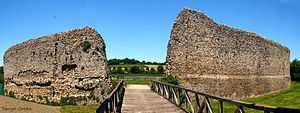Eynsford Castle
| Eynsford Castle | |
|---|---|
| Kent, England | |
|
Eynsford Castle | |
 Eynsford Castle | |
| Coordinates | 51°22′14″N 0°12′48″E / 51.370556°N 0.213333°E |
| Site information | |
| Owner | English Heritage |
| Open to the public | Yes |
| Condition | Ruined |
| Site history | |
| Materials | Stone |
Eynsford Castle is a stone Norman castle in the English county of Kent, within the civil parish bounds of the village of Eynsford. It is largely non-rebuilt and has seen natural decay but virtually no plunder for building materials. It was historically the manor owning most of the land of the village.[1] Built in 1088 and occupied by local nobility but ransacked in the 14th century it fell into decay and is now in the care of English Heritage and open to the public. For years it was used as dog kennels by the Hart-Dyke family of nearby Lullingstone Castle and manor, who were maternal descendants of courtier Francis Hart.
Architecture
Surviving fragments include sections of the curtain wall, some up to 30 feet in height, including evidence of the latrines, and buildings within the walls.
The design of Eynsford Castle is reminiscent of early German castles with a bergfried or fighting-tower forming the central element of the defences.[2]
It has been listed by English Heritage as a scheduled ancient monument.[3]
There are large ruins still remaining of Eynsford castle. The walls, which are built of squared flint, are near four feet thick, being entire for near forty feet in height. The circuit of these walls are of a very irregular form, and contain about three quarters of an acre of ground, in the middle of them is a strong keep or dungeon. It stands at a small distance eastward from the river Darent, between which and the castle, as well as for the same space about it, there is much rubbish and foundations of buildings, and there are remains of a broad moat round it, now quite dry.[4]
Social history

In the reign of Henry II of England a family of the name of Eynsford (also spelt Aynsford or Ainsford) possessed the village, one of whom William de Eynesford, was sheriff of London in that reign. They bore for their arms, a fretted ermine coat, as carved on the roof of the cloisters, at Canterbury Cathedral. A William de Eynesford held the Manor and Castle of Eynsford of the Archbishop of Canterbury (paying dues to him yearly or quarterly in the feudal system). Thomas Becket having given the church of Eynsford to one 'Laurence', William de Eynesford dispossessed him of it, for which he was excommunicated by the archbishop, a punishment that offended the king exceedingly; another such William possessed this manor and castle in the 12th and 13th years of John of England. In the reign of Edward I this estate was become the property of the family of Criol, in the 21st year of which, as appears by the Tower records (such as the Feet of Fines), John de Criol and Ralph de Sandwich claimed the privileges of a manor here; Nicholas de Criol, a descendant died possessed of it in the third year of Richard II's reign after which it passed by sale to the Zouches, of Harringworth. William Zouche died possessed of it in the 5th year of that reign, and left three sons, Sir William le Zouche of Braunfield, Edmund. and Thomas; Thomas owned it in the 6th year of Henry IV. After which it passed into the name of Chaworth; and Elizabeth, wife of William Chaworth, owned it until the 17th year of Henry VII. Soon after this, it was conveyed by sale to Sir Percival Hart, of the body of Henry VIII. His son, Sir George Hart, died in the 22nd year of Elizabeth I's reign possessed of this castle and manor, with the mill, called Garsmill, holding them of the king by knights service; since which they have descended in the same manner that Lullingstone has, to Sir John Dixon Dyke.[4]
See also
Image gallery
-
Collapsed back wall at Eynsford Castle in Eynsford Castle, Kent.
References
- ↑ Eynsford Castle, English Heritage, accessed 10 December 2012
- ↑ Friar, Stephen (2003). The Sutton Companion to Castles, Sutton Publishing, Stroud, 2003, p 36. ISBN 978-0-7509-3994-2
- ↑ English Heritage, retrieved 10th June 2013
- ↑ 4.0 4.1 Edward Hasted (1797). "Parishes: Eynsford". The History and Topographical Survey of the County of Kent: Volume 2. Institute of Historical Research. Retrieved 6 January 2014.
External links
| Wikimedia Commons has media related to Eynsford Castle. |










